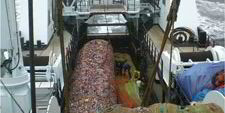Pollock were found to primarily stay within the two degrees Celsius to four degrees Celsius temperature range, and within that, king salmon bycatch is generally higher, nearing four degrees Celsius.
Had the relationship between temperature and salmon bycatch been more direct, they said it could be used by the pollock fishing cooperatives for “in-season” management to proactively avoid high bycatch zones, said study authors John Gauvin of the Marine Conservation Alliance Foundation (MCAF) and Jim Ianaelli of the Alaska Fisheries Science Center.
The
